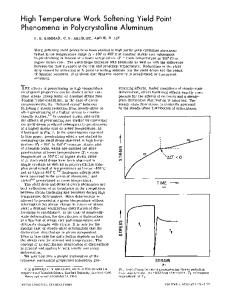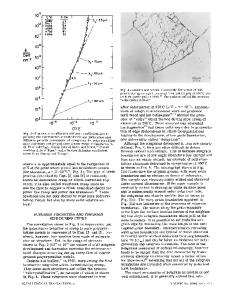Large-strain softening of aluminum in shear at elevated temperature
- PDF / 4,044,584 Bytes
- 9 Pages / 612 x 792 pts (letter) Page_size
- 47 Downloads / 322 Views
INTRODUCTION
THE stress vs strain behavior and microstructural evolution of aluminum deformed in pure shear (e.g., torsion) at elevated temperatures has been studied by a variety of groups including Myshlyaev and co-workers,[1–4] Monthiellet and co-workers,[5,6,7], McQueen et al.,[8–12] Pettersen et al.,[13,14] and Kassner et al.[15–19] The ductility of high and commercial purity Al can exceed, in torsion, equivalent uniaxial strains of 100. Typically, the Al hardens to a peak stress p,ss at strains less than 0.5. The flow stress subsequently decreases to a flow stress, ss , which is nearly constant and a steady-state condition is reached. The peak stress, p,ss , seems essentially equivalent to the steady-state creep stress observed in tension. It is generally agreed that under pure shear, such as with torsion tests, the flow stress decreases by about 17 pct and this occurs over a fairly broad range of 1 to 2 strain, depending on the temperature and strain rate, as illustrated in Figure 1.[18] This softening has not been widely attributed to discontinuous dynamic recrystallization (DRX), which often evinces softening in the flow behavior, rather only dynamic recovery (DRV) is widely accepted to occur, although Yamagata[20] insists that DRX occurs with high-temperature deformation of high-purity aluminum in compression, but this has not been reproduced by any other group. (The softening of 17 pct to strains of 1 to 2 is often followed by a slight, gradual, increase in torque (about 4 pct) above strains of about 10.[18]) The cause of the softening is not fully understood. Explanations vary from decreases in the average Taylor factor (textural softening) to changes in the dislocation substructure (e.g., increase in the average subgrain size), sometimes through increased dynamic recovery, to DRX. It M.E. KASSNER, Northwest Aluminum Professor, and M.Z. WANG, Research Associate, are with the Department of Mechanical Engineering, Oregon State University, Corvallis, OR 97331. Contact email: kassner@ engr.orst.edu M.-T. PEREZ-PRADO, Research Associate, Department of Mechanical Engineering, Oregon State University, is Researcher, CENIM, CSIC, Madrid, Spain. S. ALHAJERI, formerly Research Assistant, Department of Mechanical Engineering, Oregon State University, is Assistant Professor, Production Department, Kuwait Institute of Technology, Kuwait City, Kuwait. Manuscript submitted October 25, 2001. METALLURGICAL AND MATERIALS TRANSACTIONS A
is now widely agreed that large strain deformation results in a dramatic increase in the high-angle boundary (HAB) area. That is, one-third to one-half of the initially low-misorientation subgrain facets become HABs ( ⬎ 8 deg). Two groups[8–12,15–19] attribute this primarily to geometric dynamic recrystallization (GDX), where the original grains of the polycrystalline-aggregate elongate, increase HAB area, and “replace” the subgrain boundaries with HABs. These HABs have ancestry to the HABs of the starting polycrystal. Others have considered the formation to be additionally, or primari
Data Loading...











